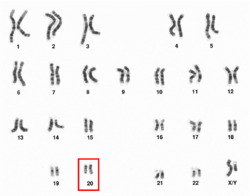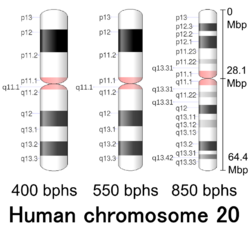Biology:Chromosome 20
| Chromosome 20 | |
|---|---|
 Human chromosome 20 pair after G-banding. One is from mother, one is from father. | |
 Chromosome 20 pair in human male karyogram. | |
| Features | |
| Length (bp) | 66,210,255 bp (CHM13) |
| No. of genes | 516 (CCDS)[1] |
| Type | Autosome |
| Centromere position | Metacentric[2] (28.1 Mbp[3]) |
| Complete gene lists | |
| CCDS | Gene list |
| HGNC | Gene list |
| UniProt | Gene list |
| NCBI | Gene list |
| External map viewers | |
| Ensembl | Chromosome 20 |
| Entrez | Chromosome 20 |
| NCBI | Chromosome 20 |
| UCSC | Chromosome 20 |
| Full DNA sequences | |
| RefSeq | NC_000020 (FASTA) |
| GenBank | CM000682 (FASTA) |
Chromosome 20 is one of the 23 pairs of chromosomes in humans. Chromosome 20 spans around 66 million base pairs (the building material of DNA) and represents between 2 and 2.5 percent of the total DNA in cells. Chromosome 20 was fully sequenced in 2001 and was reported to contain over 59 million base pairs.[4] Since then, due to sequencing improvements and fixes, the length of chromosome 20 has been updated to just over 66 million base pairs.[5]
Genes
Number of genes
The following are some of the gene count estimates of human chromosome 20. Because researchers use different approaches to genome annotation their predictions of the number of genes on each chromosome varies (for technical details, see gene prediction). Among various projects, the collaborative consensus coding sequence project (CCDS) takes an extremely conservative strategy. So CCDS's gene number prediction represents a lower bound on the total number of human protein-coding genes.[6]
| Estimated by | Protein-coding genes | Non-coding RNA genes | Pseudogenes | Source | Release date |
|---|---|---|---|---|---|
| CCDS | 516 | — | — | [1] | 2016-09-08 |
| HGNC | 519 | 191 | 297 | [7] | 2017-05-12 |
| Ensembl | 540 | 594 | 247 | [8] | 2017-03-29 |
| UniProt | 550 | — | — | [9] | 2018-02-28 |
| NCBI | 555 | 487 | 333 | [10][11][12] | 2017-05-19 |
Gene list
The following is a partial list of genes on human chromosome 20. For complete list, see the link in the infobox on the right.
Diseases and disorders
The following diseases are some of those related to genes on chromosome 20:[13]
- Albright's hereditary osteodystrophy
- Arterial tortuosity syndrome
- Adenosine deaminase deficiency
- Alagille syndrome
- Galactosialidosis - CTSA
- Maturity onset diabetes of the young type 1
- Neuronal ceroid lipofuscinosis
- Pantothenate kinase-associated neurodegeneration
- Transmissible spongiform encephalopathy (prion diseases)
- Waardenburg syndrome
Cytogenetic band
| Chr. | Arm[19] | Band[20] | ISCN start[21] |
ISCN stop[21] |
Basepair start |
Basepair stop |
Stain[22] | Density |
|---|---|---|---|---|---|---|---|---|
| 20 | p | 13 | 0 | 333 | 1 | 5,100,000 | gneg | |
| 20 | p | 12.3 | 333 | 513 | 5,100,001 | 9,200,000 | gpos | 75 |
| 20 | p | 12.2 | 513 | 624 | 9,200,001 | 12,000,000 | gneg | |
| 20 | p | 12.1 | 624 | 915 | 12,000,001 | 17,900,000 | gpos | 75 |
| 20 | p | 11.23 | 915 | 1164 | 17,900,001 | 21,300,000 | gneg | |
| 20 | p | 11.22 | 1164 | 1275 | 21,300,001 | 22,300,000 | gpos | 25 |
| 20 | p | 11.21 | 1275 | 1441 | 22,300,001 | 25,700,000 | gneg | |
| 20 | p | 11.1 | 1441 | 1608 | 25,700,001 | 28,100,000 | acen | |
| 20 | q | 11.1 | 1608 | 1774 | 28,100,001 | 30,400,000 | acen | |
| 20 | q | 11.21 | 1774 | 1927 | 30,400,001 | 33,500,000 | gneg | |
| 20 | q | 11.22 | 1927 | 2051 | 33,500,001 | 35,800,000 | gpos | 25 |
| 20 | q | 11.23 | 2051 | 2232 | 35,800,001 | 39,000,000 | gneg | |
| 20 | q | 12 | 2232 | 2439 | 39,000,001 | 43,100,000 | gpos | 75 |
| 20 | q | 13.11 | 2439 | 2578 | 43,100,001 | 43,500,000 | gneg | |
| 20 | q | 13.12 | 2578 | 2758 | 43,500,001 | 47,800,000 | gpos | 25 |
| 20 | q | 13.13 | 2758 | 3077 | 47,800,001 | 51,200,000 | gneg | |
| 20 | q | 13.2 | 3077 | 3299 | 51,200,001 | 56,400,000 | gpos | 75 |
| 20 | q | 13.31 | 3299 | 3382 | 56,400,001 | 57,800,000 | gneg | |
| 20 | q | 13.32 | 3382 | 3493 | 57,800,001 | 59,700,000 | gpos | 50 |
| 20 | q | 13.33 | 3493 | 3770 | 59,700,001 | 64,444,167 | gneg |
References
- ↑ 1.0 1.1 "Search results - 20[CHR] AND "Homo sapiens"[Organism] AND ("has ccds"[Properties] AND alive[prop]) - Gene". 2016-09-08. https://www.ncbi.nlm.nih.gov/gene?term=20%5BChr%5D%20AND%20%22Homo%20sapiens%22%5BOrganism%5D%20AND%20%28%22has%20ccds%22%5BProperties%5D%20AND%20alive%5Bprop%5D%29&cmd=DetailsSearch.
- ↑ Tom Strachan; Andrew Read (2 April 2010). Human Molecular Genetics. Garland Science. p. 45. ISBN 978-1-136-84407-2. https://books.google.com/books?id=dSwWBAAAQBAJ&pg=PA45.
- ↑ 3.0 3.1 Genome Decoration Page, NCBI. Ideogram data for Homo sapience (850 bphs, Assembly GRCh38.p3). Last update 2014-06-03. Retrieved 2017-04-26.
- ↑ Deloukas P (2001). "The DNA sequence and comparative analysis of human chromosome 20". Nature 414 (6866): 865–871. doi:10.1038/414865a. PMID 11780052. Bibcode: 2001Natur.414..865D.
- ↑ "Homo sapiens chromosome 20, GRCh37.p13 Primary Assembly". National Center for Biotechnology Information. https://www.ncbi.nlm.nih.gov/nuccore/NC_000020.
- ↑ Pertea M, Salzberg SL (2010). "Between a chicken and a grape: estimating the number of human genes.". Genome Biol 11 (5): 206. doi:10.1186/gb-2010-11-5-206. PMID 20441615.
- ↑ "Statistics & Downloads for chromosome 20". 2017-05-12. https://www.genenames.org/cgi-bin/statistics?c=20.
- ↑ "Chromosome 20: Chromosome summary - Homo sapiens". 2017-03-29. http://mar2017.archive.ensembl.org/Homo_sapiens/Location/Chromosome?r=20.
- ↑ "Human chromosome 20: entries, gene names and cross-references to MIM". 2018-02-28. https://www.uniprot.org/docs/humchr20.txt.
- ↑ "Search results - 20[CHR] AND "Homo sapiens"[Organism] AND ("genetype protein coding"[Properties] AND alive[prop]) - Gene". 2017-05-19. https://www.ncbi.nlm.nih.gov/gene?term=20%5BCHR%5D%20AND%20%22Homo%20sapiens%22%5BOrganism%5D%20AND%20%28%22genetype%20protein%20coding%22%5BProperties%5D%20AND%20alive%5Bprop%5D%29&cmd=DetailsSearch.
- ↑ "Search results - 20[CHR] AND "Homo sapiens"[Organism] AND ( ("genetype miscrna"[Properties] OR "genetype ncrna"[Properties] OR "genetype rrna"[Properties] OR "genetype trna"[Properties] OR "genetype scrna"[Properties] OR "genetype snrna"[Properties] OR "genetype snorna"[Properties]) NOT "genetype protein coding"[Properties] AND alive[prop]) - Gene". 2017-05-19. https://www.ncbi.nlm.nih.gov/gene?term=20%5BCHR%5D%20AND%20%22Homo%20sapiens%22%5BOrganism%5D%20AND%20%28%28%22genetype%20miscrna%22%5BProperties%5D%20OR%20%22genetype%20ncrna%22%5BProperties%5D%20OR%20%22genetype%20rrna%22%5BProperties%5D%20OR%20%22genetype%20trna%22%5BProperties%5D%20OR%20%22genetype%20scrna%22%5BProperties%5D%20OR%20%22genetype%20snrna%22%5BProperties%5D%20OR%20%22genetype%20snorna%22%5BProperties%5D%29%20NOT%20%22genetype%20protein%20coding%22%5BProperties%5D%20AND%20alive%5Bprop%5D%29&cmd=DetailsSearch.
- ↑ "Search results - 20[CHR] AND "Homo sapiens"[Organism] AND ("genetype pseudo"[Properties] AND alive[prop]) - Gene". 2017-05-19. https://www.ncbi.nlm.nih.gov/gene?term=20%5BCHR%5D%20AND%20%22Homo%20sapiens%22%5BOrganism%5D%20AND%20%28%22genetype%20pseudo%22%5BProperties%5D%20AND%20alive%5Bprop%5D%29&cmd=DetailsSearch.
- ↑ Gilbert F (1997). "Disease genes and chromosomes: disease maps of the human genome". Genet Test 1 (3): 225–229. doi:10.1089/gte.1997.1.225. PMID 10464650.
- ↑ Genome Decoration Page, NCBI. Ideogram data for Homo sapience (400 bphs, Assembly GRCh38.p3). Last update 2014-03-04. Retrieved 2017-04-26.
- ↑ Genome Decoration Page, NCBI. Ideogram data for Homo sapience (550 bphs, Assembly GRCh38.p3). Last update 2015-08-11. Retrieved 2017-04-26.
- ↑ International Standing Committee on Human Cytogenetic Nomenclature (2013). ISCN 2013: An International System for Human Cytogenetic Nomenclature (2013). Karger Medical and Scientific Publishers. ISBN 978-3-318-02253-7. https://books.google.com/books?id=lGCLrh0DIwEC.
- ↑ Sethakulvichai, W.; Manitpornsut, S.; Wiboonrat, M.; Lilakiatsakun, W.; Assawamakin, A.; Tongsima, S. (2012). "Estimation of band level resolutions of human chromosome images". 2012 Ninth International Conference on Computer Science and Software Engineering (JCSSE). pp. 276–282. doi:10.1109/JCSSE.2012.6261965. ISBN 978-1-4673-1921-8. https://www.researchgate.net/publication/261304470.
- ↑ Genome Decoration Page, NCBI. Ideogram data for Homo sapience (850 bphs, Assembly GRCh38.p3). Last update 2014-06-03. Retrieved 2017-04-26.
- ↑ "p": Short arm; "q": Long arm.
- ↑ For cytogenetic banding nomenclature, see article locus.
- ↑ 21.0 21.1 These values (ISCN start/stop) are based on the length of bands/ideograms from the ISCN book, An International System for Human Cytogenetic Nomenclature (2013). Arbitrary unit.
- ↑ gpos: Region which is positively stained by G banding, generally AT-rich and gene poor; gneg: Region which is negatively stained by G banding, generally CG-rich and gene rich; acen Centromere. var: Variable region; stalk: Stalk.
External links
- National Institutes of Health. "Chromosome 20". Genetics Home Reference. http://ghr.nlm.nih.gov/chromosome=20.
- "Chromosome 20". http://web.ornl.gov/sci/techresources/Human_Genome/posters/chromosome/chromo20.shtml.
 |



